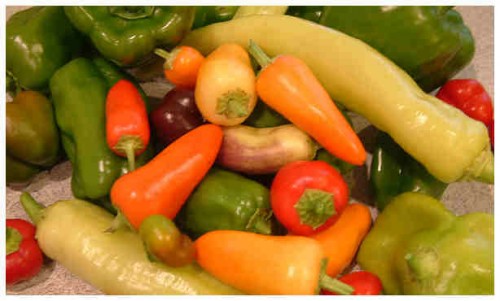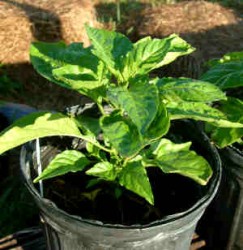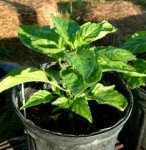Peppers Planned for 2020
It’s pepper seed time! I decided that I would go the “all seed” route for the 2020 growing season. Although I probably won’t be doing any actual planting of seeds for several more weeks, I have all my seeds ordered. So what’s in store for 2020 in my new location?
Hot Cha Cha!
I don’t have any super-hot peppers planned for this year, but I do have some hot ones ordered! Here’s the hot pepper seeds on the way:
- Purple Jalapeno:Â Seeing as I am also growing a non-heat jalapeno, I wanted to make my spicy jalapeno a different color so I could tell the two apart.
- Bolivian Rainbow:  I grew this many years ago, then had a hard time finding it again. Success! This is mostly ornamental, but the peppers are definitely edible and quite hot. I love the way these peppers have multiple colors of peppers on the bush all at once.
- Buena Mulata: Another purple pepper. This one is more like a cayenne pepper, and about the same heat.
- Tricked You Jalapeno: This is the no-heat jalapeno. I tried to grow the “Fooled You” a few years back, and I guess this one is the newer version.
- Numex Suave Orange: Supposedly a no-heat habanero. I am not sure that every pepper will be no-heat, so I will be careful when tasting the peppers.
- Aji de Sazonar: Another no-heat pepper, this time more like a serrano in shape. Supposed to be great for drying and grinding into a seasoning powder.
- Tobago Seasoning: A no-heat scotch bonnet pepper. Again, not sure that the heat will be absent from all peppers, but I imagine that the seeds and membranes will be what’s really hot.
A few more of the non-heat hot peppers than is usual for me, bit it will be really interesting to see how “no heat” the no heat peppers will be. Hmmm, now that I have all these listed out, I may hold off on either the Numex Suave Orange or the Tobago Seasoning until next year.
Cool It!
As to the sweet peppers, here’s the run-down:
- Chilly Chilli: Just an ornamental pepper. I seem to recall I tried this a few years back and didn’t have any luck, but I wanted a low-ish growing ornamental pepper that was safe to brush up against (i.e., no hot oils getting on my hands or clothes).
- Yum Yum Mix:Â Mini bell peppers, kind of like the ones I’ve been seeing pop up in the grocery stores lately.
- Sweet Pickle: Another ornamental, a lot like Bolivian Rainbow, but with a slightly larger pepper. This one is like Chilly Chilli, supposed to be safe to brush up against, etc.
- Petit Marseillais: Something like a cross between a bell pepper and a frying pepper, but more like the bell. Supposed to be very sweet.
- Roumanian Sweet: This is a bell pepper. I grew it many years ago, it changes color from a pale greenish-white to purple to orange and then red. It was quite tasty.
All in all, this should be an interesting year for peppers.
Planting Seeds
I have a couple new seed sprouting things I want to trial, so that post will be coming up (actually, probably more like a series of posts).
Bhut Jolokia – The World’s Hottest Pepper
Bhut Jolokia is the reigning world’s hottest pepper. The most pungent tested over 1,000,000 Scoville Units. That’s beyond hot!
I decided to grow some jolokia in my garden, along with some mustard habanero and some scotch bonnet peppers. The ultimate comparison should be quite interesting!
About Bhut Jolokia
 This nuclear-heat chile pepper is known by several names. In addition to Bhut Jolokia, it’s also known as Naga Jolokia, Nai Miris, Ghost Chili, Ghost Pepper and Naga Morich. Yes, it’s a little confusing (to say the least).
This nuclear-heat chile pepper is known by several names. In addition to Bhut Jolokia, it’s also known as Naga Jolokia, Nai Miris, Ghost Chili, Ghost Pepper and Naga Morich. Yes, it’s a little confusing (to say the least).
This chile pepper comes from the Indian sub-continent, and thought to have originated in Northeast India, in Nagaland.
There’s been some controversy over this pepper; some say that the testing (done by 3 different labs) was hoaxed and nothing could top 1 million Scoville. But, the Chile Pepper Institute, run by New Mexico State University, ran tests in 2005 and yes, it was over 1,000,000 Scoville.
In February 2007, Guinness World Records certified the Bhut Jolokia (Prof. Bosland’s of the Chile Pepper Institute’s preferred name for the pepper) as the world’s hottest chili pepper.
There’s a question if the jolokia pepper is a member of the capsicum chinense or capsicum frutenscens family. I’m going to go with c. chinense, because the plant looks very similar to the Mustard Habanero plant I am growing in a different part of the garden.Â
(You can read read my pepper types post for more information on the different species.)
Growing Bhut Jolokia
The seeds aren’t exactly cheap (I paid about $1 per seed), and I started 2 seeds. Both sprouted, but one was felled by (I assume) the weather. The other one is doing beautifully!
The photo above is about a week before I planted it in my new raised bed garden. Since it’s been in the raised bed it has flourished and is a beautiful plant. It’s just now starting to form some flower buds, and before the buds open, I am going to bag the blossoms, so I can be sure of having more seeds going forward.
I’ll be posting more about Bhut Jolokia, the world’s hottest pepper, in the future, especially once the peppers start to form. And it will be quite interesting to compare it against my Mustard Habanero and Scotch Bonnet Early peppers.
Stay tuned!
Germinating Pepper Seeds, Update
It’s been just over a week since I planted my latest batch of pepper seeds, both hot and sweet. So what’s sprouting already?
And the Winner Is…
Corno di Toro, a sweet pepper, was first out of the gate at 5 days. However, of the two seeds I’ve planted, only one has shown up yet. On the other hand, I planted two different strains (confused yet?). At any rate, the red Corno di Toro is the clear winner.
Jalapeno M was the second to sprout at 6 days, with both seeds coming on up. Jalapeno M was closely followed by Cambuci Hot, about a half day behind.
The next two sprouted at nearly the same time — Nardello Sweet and Mini Belle.
And finally this morning — Mustard Habanero. Wow, a super-hot pepper in 7.5 days — amazing.
I’m Waiting On
Some “hotties” — Hot-Banero, Peter Pepper and Bhut Jolokia. Also lagging are two more jalapenos — Jaloro and Tam Jalapeno. Brazillian Rainbow is also nowhere to be seen yet. I know — patience! And considering 10 to 21 days is the usual for hot chile peppers, it’s great that some have already shown their faces (er, leaves). Yes, the seed germination mat I talked about does work well, shaving days off the sprouting.
Thinking About a Transplant
Purira pepper (quite hot) is growing very strong and looks like it will need its final transplant before going outside to harden off for the garden in the next few days. Seeing as I did its first transplant early last week, this one appears to be a winner!
Other pepper seeds that need their final transplants before hardening off include Redskin, Anconcagua and the last of the sweet banana peppers. For Sweet Pickle I just did its first transplant on Saturday, and it appears that it will need its second transplant this weekend — wow, that was fast!
More Seeds?
I think I’ll take a short break, since I have at least 20 pepper plants at the moment, not counting the ones that are just now sprouting. Come the middle of April, it will be time to start thinking about my late Summer wave. I’m planning on the following peppers for then: Datil, Tennessee Teardrop, Ring of Fire, Yellow Cayenne and Scotch Bonnet. On the cooler side it will be more Sweet Banana, along with Anconcagua and probably Nardello Sweet. Perhaps Mini Belle again, if small bell peppers work well for me.
Have You Planted Your Seeds Yet?
I know, it’s been a cold winter, and for many of you, putting pepper plants into the garden is many months away. But for you folks in zones 8, 9 and 10 — it’s pepper “prime time”. Get planting!
P.S. — it’s a few hours later and both my Corno di Toro, both Cambuci and both Mustard Habaneros are up. Even Peter Pepper is starting to break through! What a difference a few hours can make. 🙂

